Editor’s Note: This week we’re taking it all the way back to a post from 2015, one of the most memorable guest posts we’ve ever had on the blog… The dog whisperer herself, Kaylee Greer! This was her introduction to the Kelby world, before any of her KelbyOne classes, Photoshop World classes, Dogtography book, podcast, or NatGeo TV show. And if you don’t already know her, well, buckle up… She’s going to take you on an exciting ride!
Hi! I’m Kaylee. And I’m going to tell you something that will knock your socks right off. Ready?
I love dogs.
And oh my gosh, I wish I could say this in a sort of casual, non-chalant, “Yeah I think dogs are pretty cool, no big deal,” sort of way. But you guys… I mean it. I mean like, in a totally and completely bonafide ‘crazy dog lady’ kind of way.
So, it’s kind of embarrassing when I walk down the street and audibly and uncontrollably squeal with delight over every little wiggling, passing pup I see. My friends actually try and deter me from the path of an oncoming dog as we walk down the sidewalk – for fear that we’ll get stuck in a 25 minute interaction that includes me excessively ogling, squishing and kissing a strange dog with a sometimes slightly terrified owner looking on.
The truth is, I find more beauty, purity and joy inside the iris of a happy dog than I do anywhere else in the world. When all else seems to fail me – I find solace in the smile of a dog. Dogs have this perfect ability to live simply – to live in the moment. And that just fascinates me.
Luckily for me, I was blessed enough to be able to turn my copious amounts of “dog crazy” into passion – and that passion into a profession.
Yup, you heard it here folks – I am a professional dog photographer.
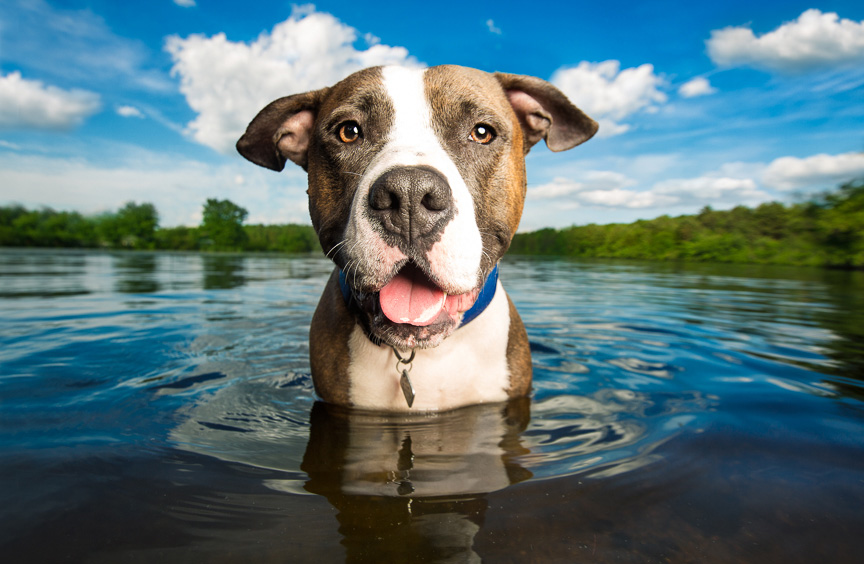
I know, I know. “WHAT?” (accompanied by a cocked head, big eyes and sometimes a giggle at my expense; this is the typical response I get when people first discover my job title.) A professional dog photographer. I’m wildly humbled and grateful to say that I’ve turned that passion into a very busy reality that has me booked almost one full year ahead with both private and commercial shoots. Who would’ve thought that could even be within the scope of reality for someone who only photographs dogs?! Good gravy! Sometimes I have to pinch myself. I wake up every day and smile. I smile because life is so silly and full of wonder. I smile because Im living my real live dream. And that dream is called Dog Breath Photography.
If you told my five-year-old self what my profession would one day turn out to be – I think her head would have actually popped off with joy. If you hang on just a sec, I think I can hear her squeals of delight from all the way back in 1990. Holy banana sandwiches.

So, after being invited to write this guest post on Scott’s blog (but not before I finished the elaborate robot dance of joy that I executed quite fabulously all alone in my studio with my dog looking on judging me harshly), I thought how wonderful it would be to share some of my best tips and tricks. The little golden nuggets of wisdom that I’ve felt blessed to have learned over the past 5 years of my dog photography adventures. While getting great photos of your client’s or your own pets sometimes feels impossible – I can assure you with the utmost conviction – it’s not.
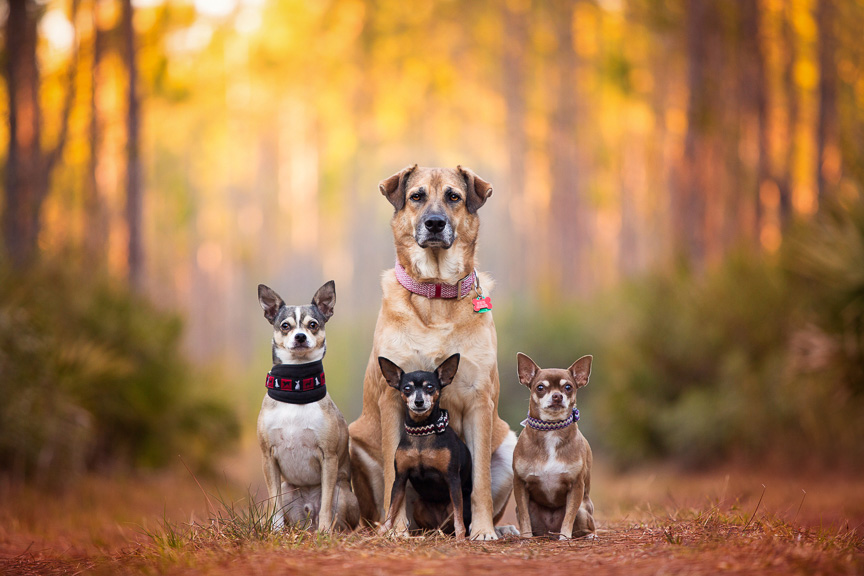
I’ve got some stuff up my sleeve that you just might find helpful – especially when you’ve got Rufus set up for the most perfect shot, arranged meticulously in the gorgeous, golden afternoon light, and he suddenly runs off in the direction of that squirrel for the 45th time. (Let me tell you now, as much as you try to reason with them, dogs just don’t appreciate the nuances of really good light.)
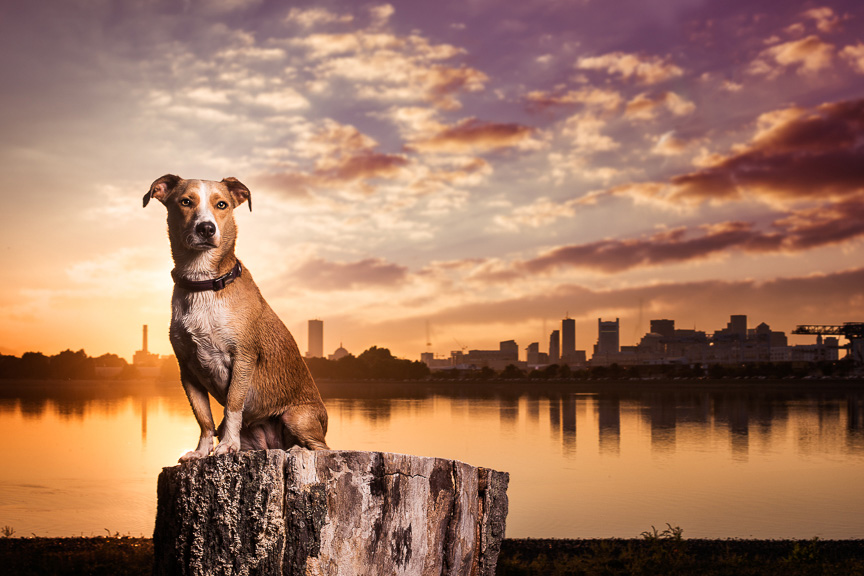
So, let’s dive into some content that will help you get amazing shots of your pets, that will create the illusion that you’re working with a perfectly trained dog every time.

As we all know, your average dog is anything but stagnant. No, he moves. And when I say, “he moves,” I mean like, 65mph moves. Like with more quickness and speed than the fastest, angriest ostrich on the savannah.
And not only does he move – but he drools. He barks. He chases his tail in endless circles. He has the attention span of a gnat.
But most significantly, he speaks an entirely different language than you and I. I know what you’re thinking. Not the easiest subject for a photograph, right? Precisely.
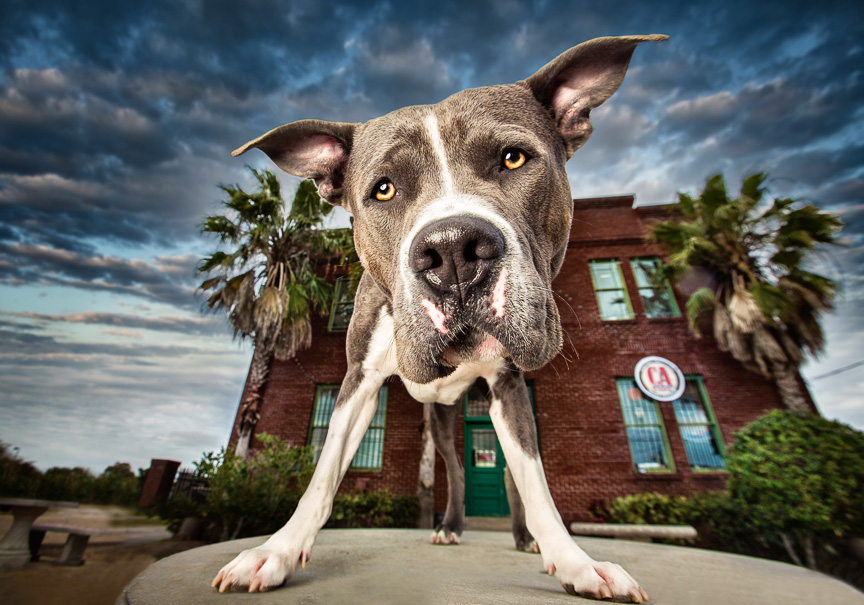
Some of the first things that people ask me when they see my images are:
“How do you get all these dogs to pose so perfectly for you like that?” “Do these dogs just sit there, hold exactly still and smile for you?!” “Are these magic dogs from a magical land?”
The answer to that last question is an enthusiastic ‘no.’ While I’ve had a few dreams about this (these elusive, magical, still dogs), I photograph regular dogs. Real dogs. The dogs you see walking down the street every day. The dogs that fly through the dog park at about a gazillion miles an hour. The naughty dogs that dig holes in their owner’s tulip gardens and bury bones in their backyards. Dogs that sniff other dog’ butts. Dogs that lie on their family’s couches and fart.
You know, those kinds of dogs.
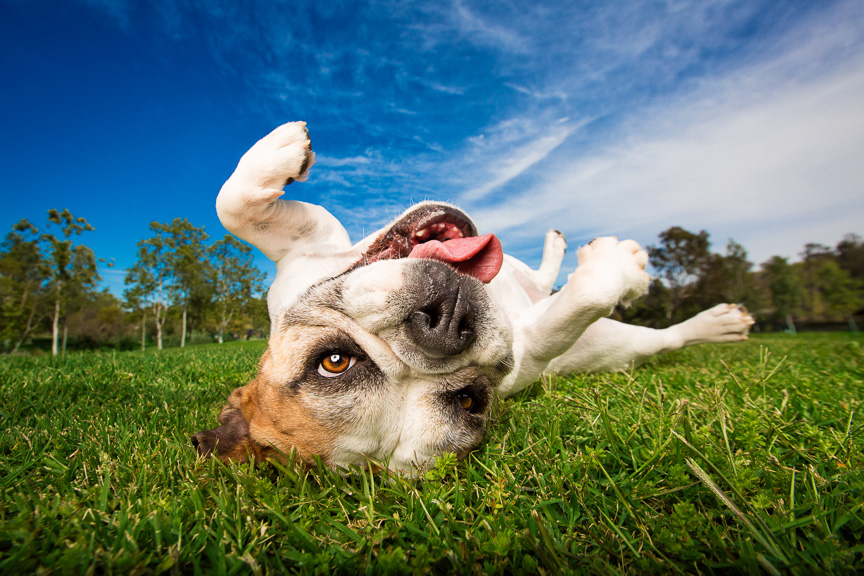
In addition to working with lots of regular family dogs, I also volunteer my time to busy, overburdened animal shelters – photographing homeless and abandoned animals who are waiting for a new family to adopt them. Some of these shelter dogs can be rife with a whole different set of behavioral and emotional issues due to the transitionary states of their lives – fearfulness, abandonment, aggression, loneliness, confusion. Even with these sweet, sweet lost souls who lack the stability of a home and family to call their own – with enough knowledge, kindness of heart and patience, you can get a winning image.
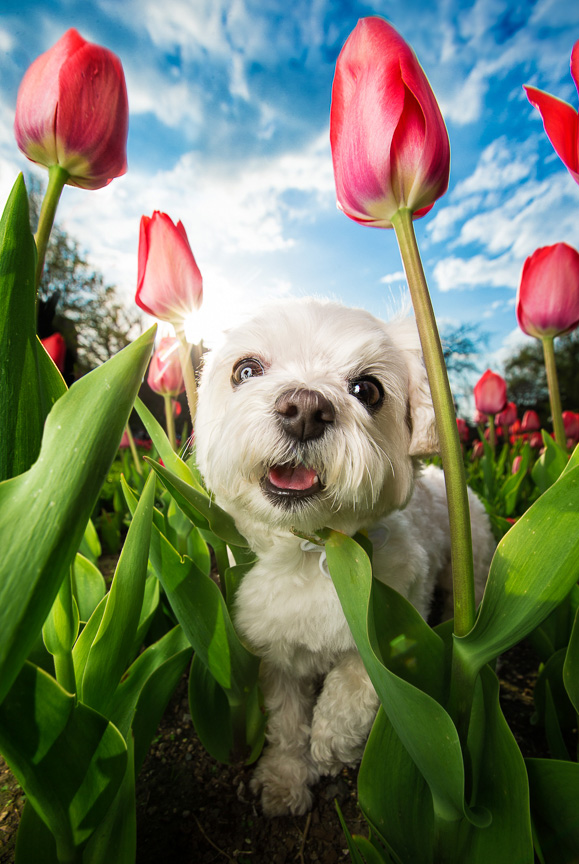
You wouldn’t travel to a foreign country and expect them to speak your language right? The same thing goes for dogs. Don’t enter a dog’s world and expect them to speak your language – you need to speak theirs.
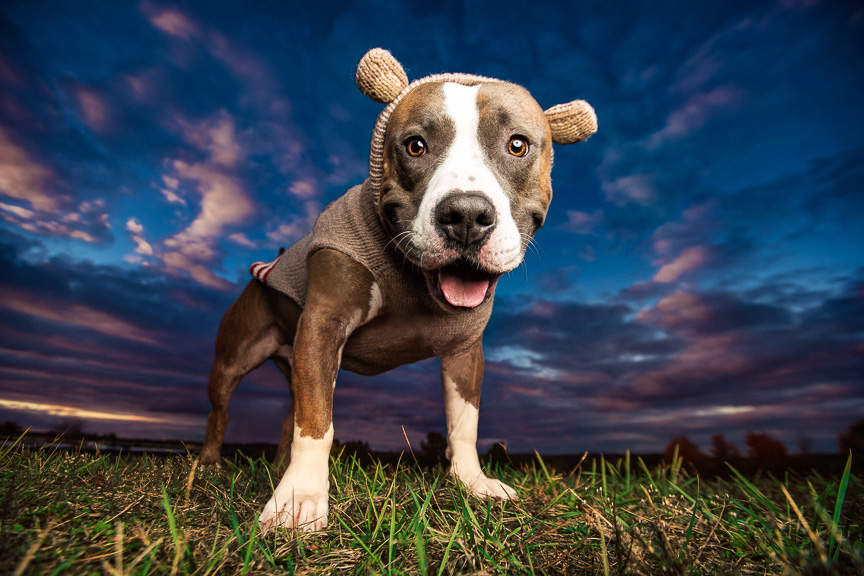
Dogs talk through their eyes. Their ears. Their tails. Their body posture. Dogs talk with sounds – growls, whines, barks – you name it. If you want to understand the language of a dog – you need to immerse yourself in their world. Be quiet and listen. Once you spend enough time with a dog you’ll learn about what most motivates them. You’ll find that canines tend to go totally gaga over one or more of the following things:
- TREATS (because, you know…yum!)
- PEANUT BUTTER (this stuff is most dogs’ kryptonite, I’m serious! For dogs that can’t have peanut butter, cream cheese or canned pumpkin will also work just fine.)
- TOYS (ask me how many Barbie dolls I had when I was 9…I totally get this one.)
- SOUNDS (things that go squeak! The most successful way to evoke the elusive and highly coveted head tilt. And a great way to get the mouth closed and ears pricked up at attention.)
- PRAISE (dogs LOVE praise. “HEY DOG! YOU ARE AWESOME!!”)
- THEIR OWNERS (oh HELLO my humans! I want to love you forever and ever and ever and ever ::slobbery kisses::)
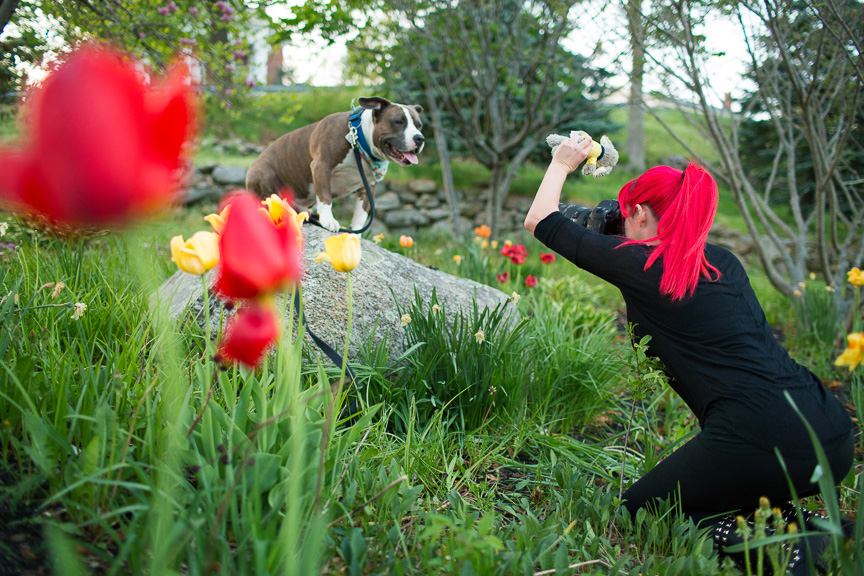
A behind the scenes look from a recent photo shoot. Joshua, above, is wildly motivated by toys. A well-timed squeak here and there, and you’re in business!
So, based on the above motivators, I try to have something in my bag for dogs of every shape, personality type, size and energy level. The trick is to have something on hand at all times that can be used to leverage your fuzzy subject’s attention.
Here’s a look into what I carry in my treat bag to every shoot:

Now let me introduce you to a few furry case studies, based on their very real, and very favorite motivators / greatest weaknesses:
PEANUT BUTTER
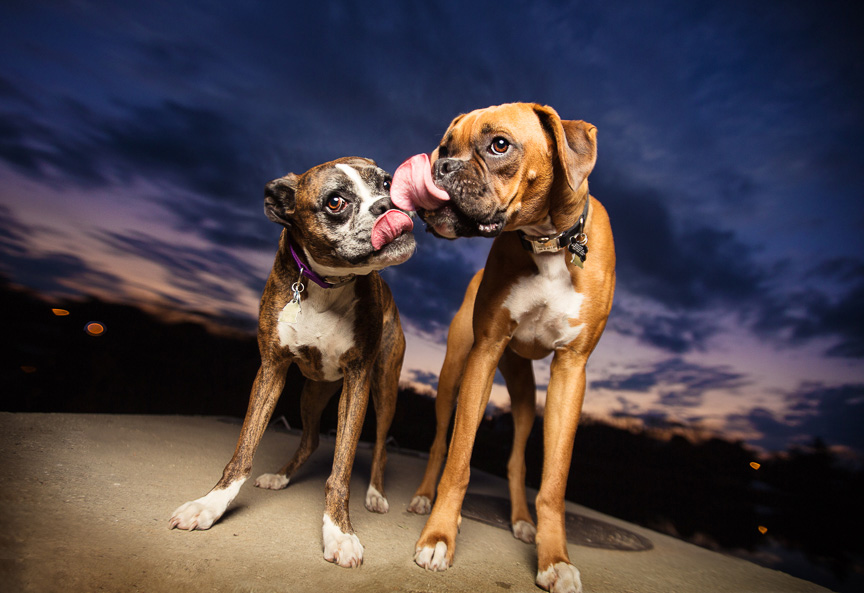
This is Bailey and her brother Sheldon, hopelessly addicted to peanut butter. These two were over-the-moon for the gooey, creamy, peanut-ey miracle of peanut butter. A dollop of PB magic on each of their snouts, and voila! Kissing boxers!
TOY / BALL
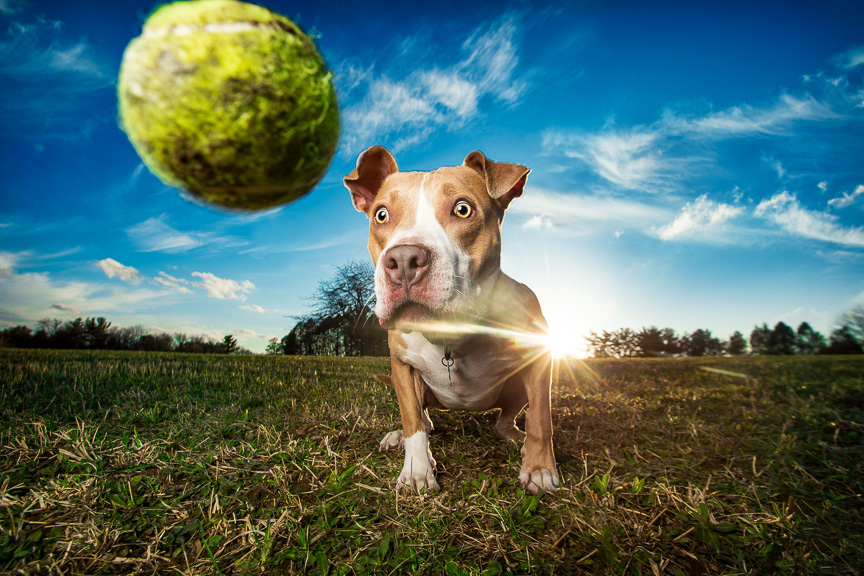
Somebody organize an intervention for Prince, he’s a downhill tennis ball addict.
TREATS

This is Logan. Or as I like to call him “Treats McGee: Mayor of Doodletown.” This short legged little dude couldn’t get enough of the goodies on offer that afternoon, and would often be caught making this face if there was a lapse in the treat handouts. “How dare you stop the cookies?!”
OWNER
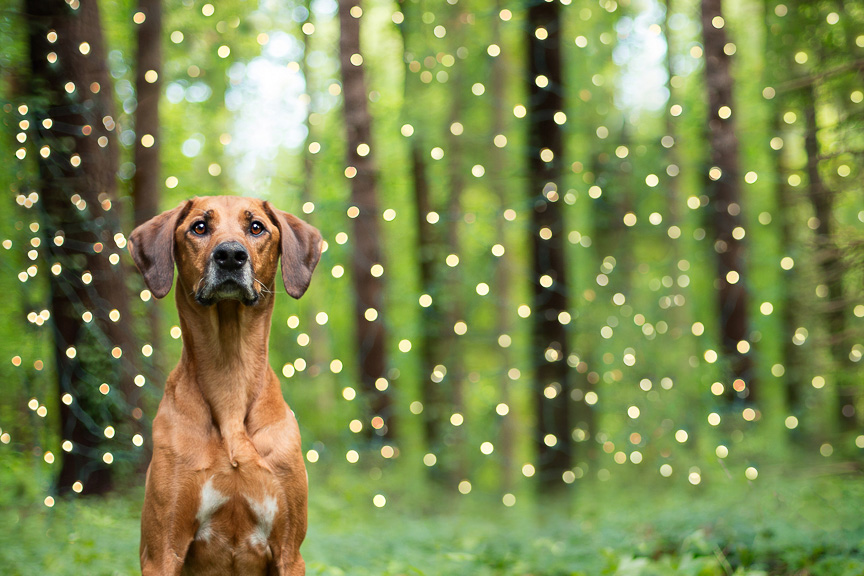
Oh, sweet Howler. Talk about a dog dedicated to his owner. Howler had hearts in his eyes for his Mom. He sat like a perfect gentleman for his photos as she directed him from behind my camera. (Howler is the exception to the rule in terms of dog behavior. Howler is actually the exception to the rule for most things. An unbelievable dog with a brilliant spirit who passed away shortly after our photo shoot. As a side note, sometimes, in this industry, your heart shatters in your chest and melts out through your feet.)
The number one priority at any photoshoot is safety. That being said, the concern of safety is amplified infinitely when dogs are involved.
When working with animals – always expect the unexpected. I can’t balance a puppy on a fence, tall stump or high rock without knowing for sure that he’s not going to embrace his inner Wonderdog and fly off the edge like a superhero. And, Unfortunately, since dogs don’t speak English and can’t tell me what sneaky and adorable maneuver they’re planning next – I have to take extra precautions to ensure that we don’t end up with four very cute, but very broken puppy legs or a dog that has playfully run off into traffic. (Cue the sad trombone). So, even with the most well trained dogs, there are certain precautions we always take – especially when shooting in busy areas.
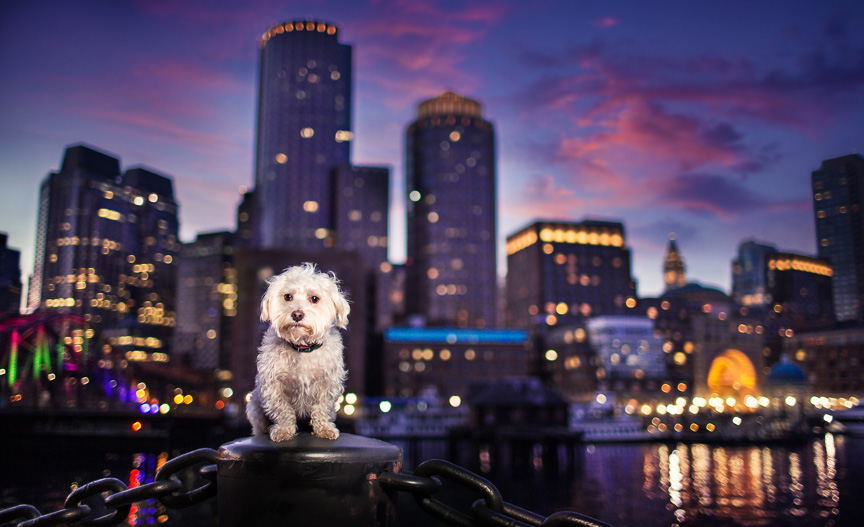
Here’s where some of the secret tricks come in. Believe it or not, about 70% of all dogs that I photograph both privately and commercially are on leash at the time that their photos are being captured. (The 30% that aren’t tend to be impeccably trained dogs with a very high level of obedience and reliable recall skills in quiet countryside locations with minimal distractions.)
Getting quite good at removing leashes from my images in the post processing stage of things became an early requirement for me. In order to keep my gorgeous furry subjects safe and happy – it is imperative that I have total control of the situation while shooting on-location. So, In the majority of scenarios, that means puppies safely tethered on leashes for their big close-ups!
Check out a few before and afters below!

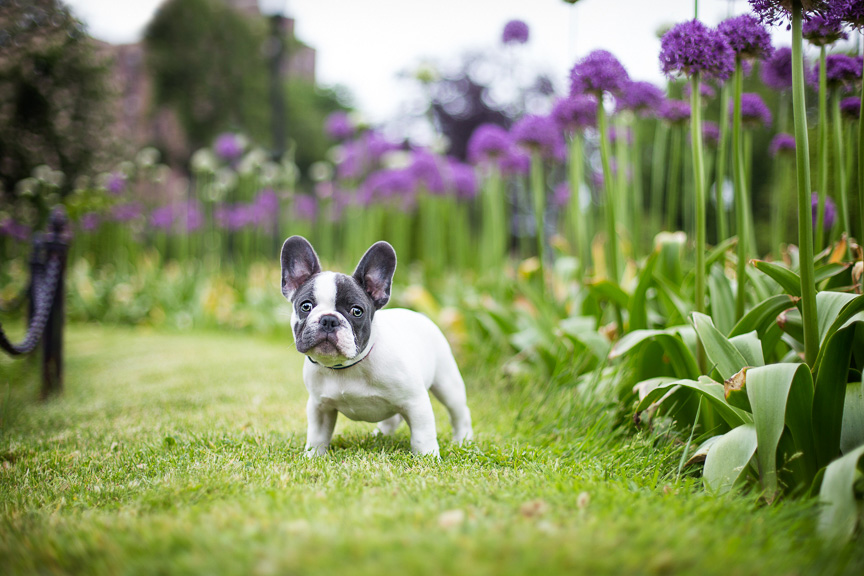

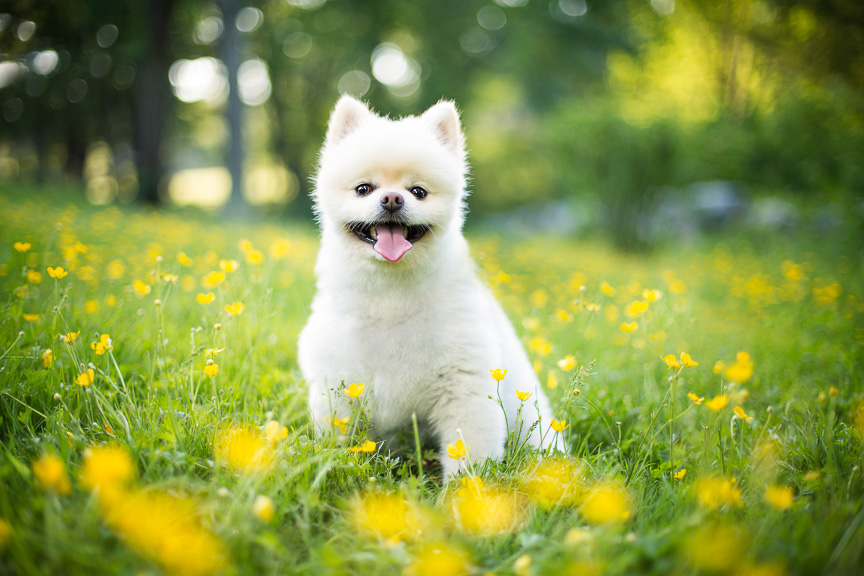
Another great thing about using leashes while capturing images of dogs is that you can use them as a tool to keep your subject in a general spot that you’ve chosen. If you can find a very strong and stable element within your shot environment, like a tree, fence or rock – you can then tether the dog in place with his leash to keep him there. Once you have the owner free to move away from the dog and stand back behind you – it is almost a total guarantee that the dog is not only going to be placed where you want within your frame, but also looking intently in your direction.
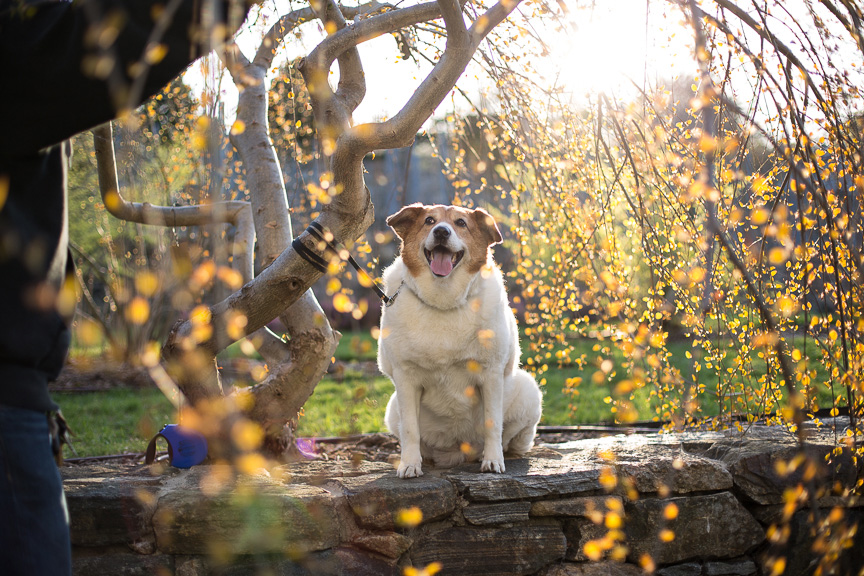

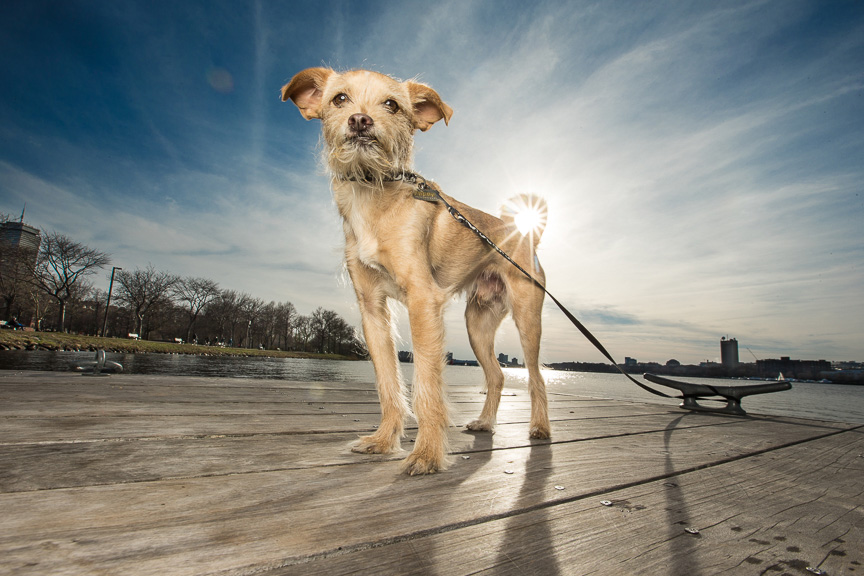
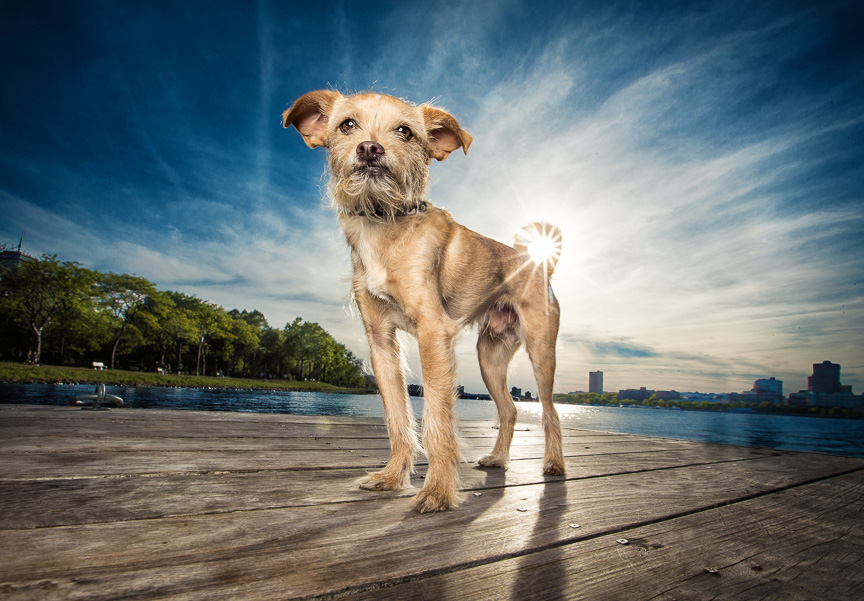
If you find there’s nothing in the environment you’re shooting in to tether the dog safely to, there’s another great solution! You may have also noticed above that I have a tie-out stake in the contents of my treat bag that I posted above. The stake is an invaluable tool and has been a saving grace at more photoshoots than I can count. Simply twist into the ground (all the way in so that it’s nice and sturdy, especially for big dogs) and voila! You have a place to tie your subject that doesn’t impede on the aesthetic of your shot and is quite simple and easy to remove in Photoshop later.
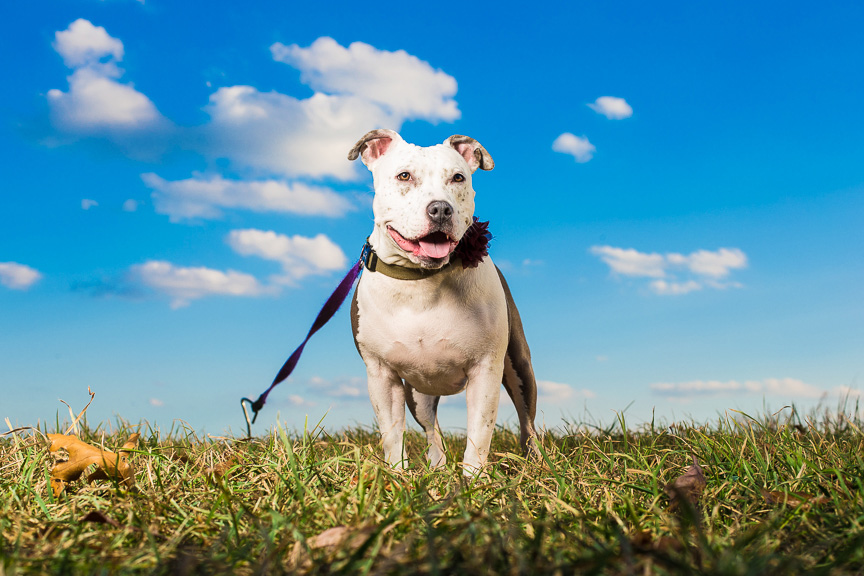
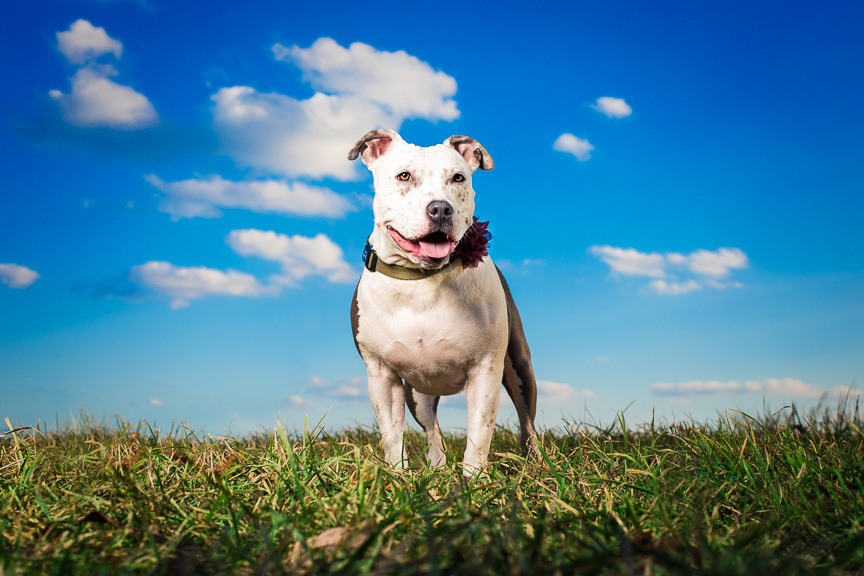
And of course, as life tends to go, there are always going to be situations where none of the above will work well. Situations that fall a little outside of the box. Here’s an example:
We were shooting with Mia the Yorkie and Jack the Boston Terrier on a wooden dock floating on the Charles River in Boston at sunset. Here, there were of course no trees, rocks or roots we could tie the pups to. And of course, we couldn’t screw the stake in because we weren’t on land. In this case, we had to utilize the fuzzy duo’s owners to help puppy wrangle and keep the them in their places. As you can see in the before shot, Mia was being held by her Dad, and Jack by his Mom. Once I nailed the shot I wanted of the pups, without moving too much, I asked everyone to step out of the frame. I locked my focus and proceeded to shoot a few plates of the background – images I could use later to paint back in to the shot to successfully remove Mia and Jack’s parents from the final image.

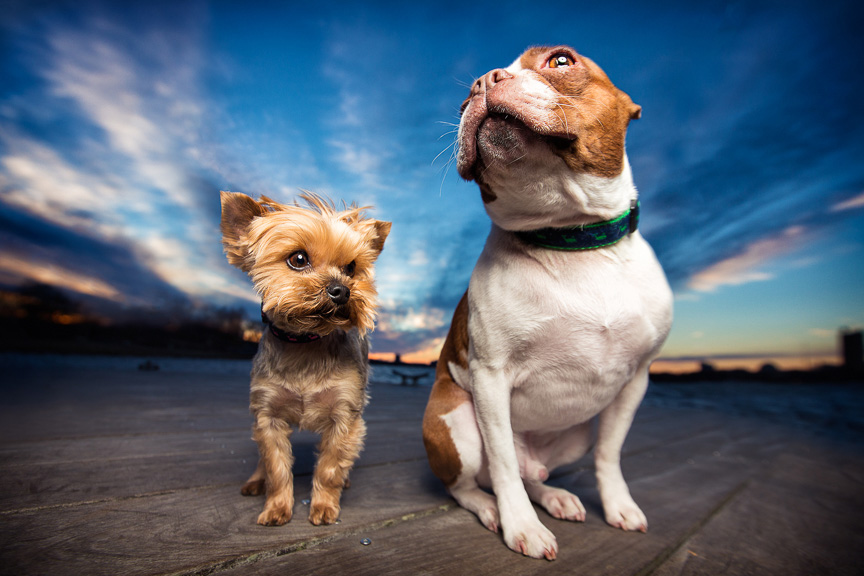
We recently traveled to Australia to teach a series of pet photography workshops. While there, I was lucky enough to have the incredible opportunity to work with a few animal rescues in some of the regions we were passing through as we journeyed across the country. We met this gorgeous little Kelpie puppy at a shelter in Port Douglas and were so grateful to be allowed to take her from her cage and bring her on location to create some special adoption photos. Naturally, we decided to take her to the beach (tropical Australia by the Great Barrier Reef? I mean…is there really any other option?!)
Because we were traveling abroad, we didn’t have our regular gear with us. Without the stake or any trees or fences in the area, we found we had nothing to tie this sweet puppy to to get her in place for this shot on the sand. So what do you do when you’re on location with a gorgeous puppy in tropical Queensland and you need to get the shot? You improvise!
In this case, we used our 40+ lb camera bag to act as stake to hold this sweetheart in place. As a young, small puppy – we knew she couldn’t feasibly drag this camera bag with her off into the sunset in a quick getaway. So we shot with her tethered to the bag, with the intention of removing it later in photoshop.
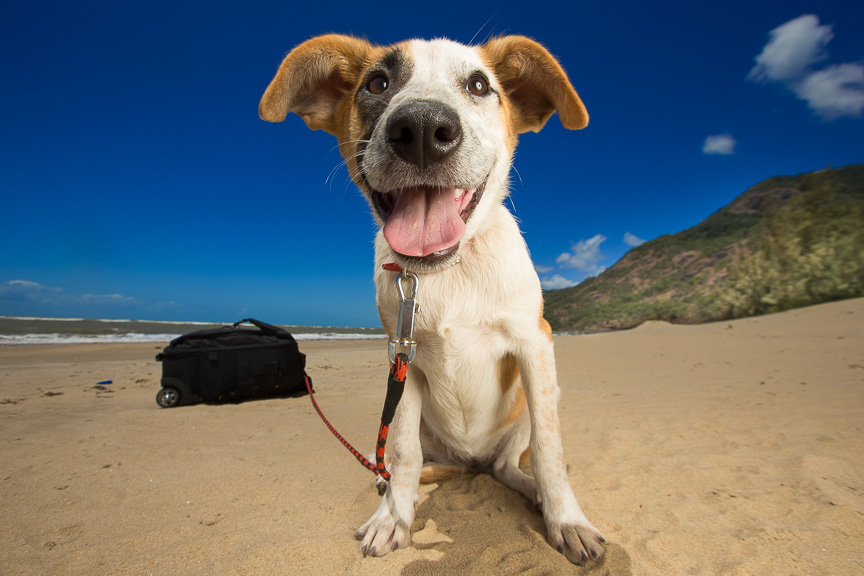
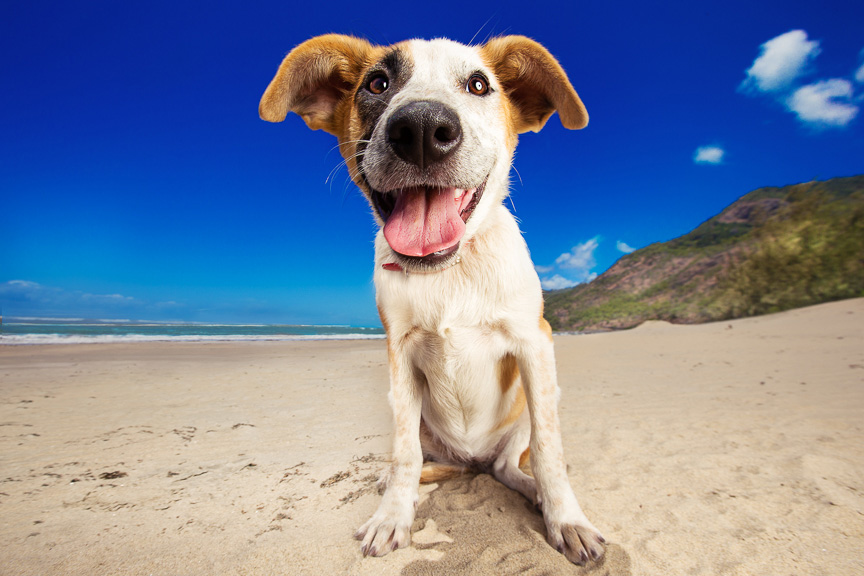
In the end, above anything else, the most important thing to remember when photographing dogs is to always keep patience in your heart. We live in such a fast paced world that, as humans, I think sometimes we forget how quickly and urgently we tend to move throughout life. Always remember, dogs don’t live by a clock like you and me. And that’s part of what makes them so unbelievably special. Their world is not measured in minutes but in moments. Be gentle and have patience – it will be your greatest tool. You may need to fire off 100 frames of a dog before you create something even remotely interesting and usable. And that’s perfectly okay. If you can pull enough enthusiasm, passion and whimsy from your heart, it’s inevitable that you will find magic.

A dog spends every one of their days on this earth spreading kindness, happiness and joy. With each wag, each smile, each paw print in the sand – they are writing a legacy. As they move throughout this world, they can light up even the darkest night with the brilliance of their unconditional love. With no voice of their own to speak their story, it is entrusted to us – their greatest friends – to capture the timelessness of their spirit. And if you’ve ever been lucky enough to love a dog, you know that the sparkle in his or her eye – the one that sets your soul on fire each time you look their way – fades out much too quickly over the course of their criminally short life. So don’t wait until tomorrow – spend today in their joyful presence. Make memories. Freeze those tiny moments into little pieces of forever. Pieces you can slip into your pocket and hold close to your heart once they’re gone. It’s your job to preserve their smile, your job to tell their story.
Because every dog has a story worth telling.
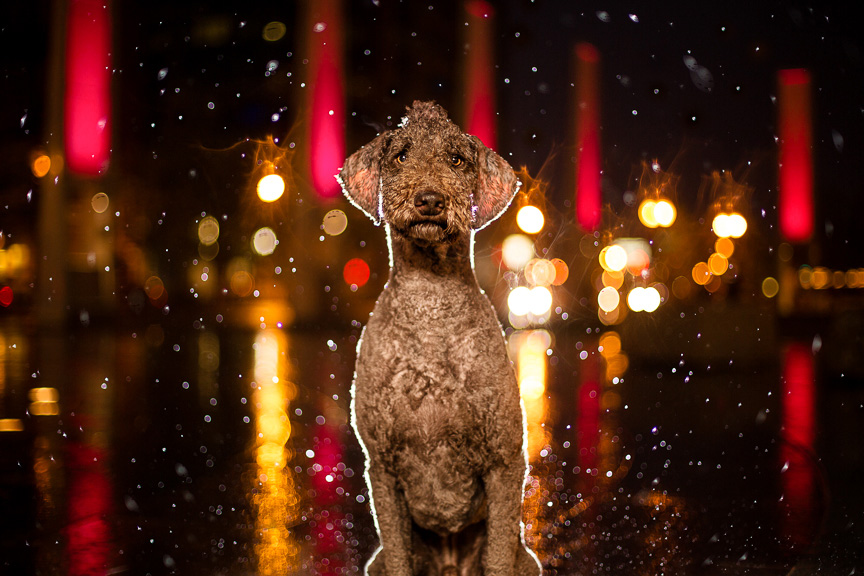
If you have any questions, thoughts or experiences photographing dogs of your own, please feel free to share them in the comments! I would be over the moon to hear from you! Thank you endlessly for spending this time with me here on Scott’s blog. (and a huge thank you to Scott + Brad for inviting me along! I might explode with gratitude.) 🙂
With all the love and kindness I can muster up,
-Kaylee Greer
Dog Breath Photography
You can see more of Kaylee’s work at DogBreathPhoto.com, and follow her on Facebook, Twitter, and Instagram.